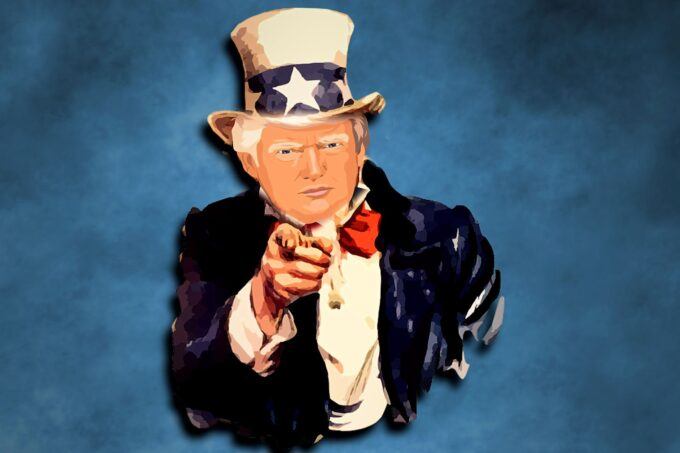Donald the Taxman Strikes at Midnight

Super-Cargo ship entering the Columbia River at Astoria. Photo: Jeffrey St. Clair.
The waiting is over, Donald Trump has hit America’s workers with the largest tax increase they have ever seen. Trump’s taxes on imports (tariffs) from Canada, Mexico, and China will cost people in the United States somewhere around $400 billion a year or around $3,000 a household.
This is far larger than any tax increase we’ve seen in the last half-century, and unlike tax increases put in place by Clinton and Obama, it will primarily hit low and middle-income households. Their tax increases primarily hit the top 1% percent, which is probably why they got so much more attention from the media.
It is not clear what our reality TV show president hopes to accomplish with these tax hikes. His stated reasons don’t make much sense. Canada, Mexico, and China are already cooperating with the U.S. on the issues he is complaining about. There is a minimal flow of fentanyl and undocumented immigrants from Canada.
Mexico sharply curtailed the flow of undocumented immigrants following a deal with Biden last summer. We can look to reduce the flow further, but that could probably be accomplished by negotiations rather than imposing a big tax on U.S. households.
China has also cooperated in reducing the flow of precursor substances for making fentanyl. Here also there were probably better prospects for further reductions through a path of negotiations rather than Donald Trump’s big tax increases.
Also, unlike Canada and Mexico, China’s economy is not that dependent on its trade with the U.S. China’s exports to the U.S. come to less than 2.5 percent of its GDP. If Donald Trump’s taxes reduce that by half, it could look to export to other countries (like Canada or Mexico) or increase domestic demand.
It seems implausible that Donald Trump’s stated reasons for his tax increase are his actual reasons. In principle, taxes on imports can be used as part of an industrial strategy to build up key industries, as was explicitly the case under Biden. His tariffs were intended to promote the advanced semi-conductor industry, as well as solar and wind energy and electric cars.
However, it would be difficult to find any evidence of an industrial strategy in Trump’s plans. He actually is deliberately sabotaging the industries Biden sought to foster.
There is an old saying in Washington that if you want to understand politicians, look at what they do, not what they say. On that front there is no ambiguity. Donald Trump is imposing big new taxes, and he is doing it in a way that does not require congressional approval.
He has made no secret of his intention to cut taxes on the wealthy. While Elon Musk and DOGE boys have put on a good show with the chain saw and breaking into various government agencies, the savings they can actually identify don’t amount to much.
If Trump can’t find major savings in the budget, then he will have to raise other taxes if he doesn’t want to hugely increase the deficit with his tax cuts for the Elon Musk crowd. This is the most obvious explanation for Trump hitting us with his huge import taxes. It sounds much better to pretend he’s cracking down on fentanyl and illegal immigration than to say he’s whacking ordinary workers with a big tax increase. But that is what Donald Trump is doing.
Trump’s Record Large Tax Increase

Image Source: kalhh – CC0
The taxes on imports (tariffs) that Donald Trump is putting in place next week, coupled with his earlier taxes, will rank among the largest tax increases ever imposed. They are far larger than the tax hikes put in place by Presidents Clinton and Obama, which sent Republicans into a frenzy.
The basic story, as it stands now, is that Trump will impose 25 percent taxes on imports from Canada and Mexico, while increasing his 10 percent tax on imports from China to 20 percent. Our imports from Canada and Mexico together came to roughly $1 trillion last year, while our imports from China were a bit over $400 billion.
This means that, before any resulting adjustments in trade patterns, the tax would come to $330 billion ($250 billion plus $80 billion). There are many issues with this simple calculation. Trump may allow some items, like Canadian oil, to be taxed at a lower rate. However, the figure also excludes Trump’s tax on steel and aluminum imports from other countries, which would make the tax considerably larger.
This means that we can use this $310 billon figure as a reasonable approximation of the size of Donald Trump’s tax increase. With GDP coming in at around $30 trillion in 2025, this tax hike would be equal to 1.0 percent of GDP.
By comparison, the tax hike that Bill Clinton pushed through in 1993, primarily on high-end taxpayers, came to 0.66 percent of GDP. The tax increase that President Obama pushed through in 2010 to cover the projected cost of Obamacare came to 0.43 percent of GDP, less than half the size of Trump’s tax hikes, as shown below.

If Republicans are really opposed to tax increases, they should be outraged about the huge taxes that Donald Trump is imposing on imports. On the other hand, these import taxes will be paid disproportionately by low and middle-income families, since they both spend a larger share of their income than rich families, and what they do spend goes disproportionately to goods rather than services. (Low and middle-income households are less likely to spend money on fine dining and foreign vacations.)
If the Republicans’ main concern is taxes that rich people pay, then it is more understandable that they would not be upset about the huge taxes Donald Trump is imposing on imported goods. The rich will be less affected by these taxes and can be more than compensated by tax cuts that Trump has promised them.
The Elites Big Lie on Equality

Photograph by Nathaniel St. Clair
(I saw that Jeff Bezos wants the Washington Post’s editorial page to run pieces touting the merits of free markets. Here’s my submission.)
There are not many issues on which there is largely bipartisan agreement, so the story we tell about the origin of economic inequality stands out. Both sides agree that the increase in inequality of income and wealth is driven by an unfettered market. The difference is that conservatives say it is wise to accept the outcomes of the ‘free market,’ while people on the left believe the government should ameliorate the effects of the market.
But both sides accept that inequality is caused by the market. This is nothing but a Big Lie that bolsters elite interests.
The reality is that there is no “the market” out there generating inequality. The government structures the market, which is infinitely malleable and can produce almost any outcome we want. Over the last half-century, we have increasingly structured markets in ways that generate more inequality — a reality that our economic policy debates largely refuse to acknowledge.
Let’s start with the clearest example: government-granted patent and copyright monopolies. These are government policies to promote innovation and creative work. Since we have seen lots of innovation over the last half-century, one could argue these are good policies. However, the economy actually had faster productivity growth (the economic measure of innovation) in the quarter century following World War II — a time when there was less inequality, and these monopolies were less important. Recent policies have made these monopolies longer and stronger.
In the case of prescription drugs, while patents monopolies provide incentives for innovation, they also provide incentives for drug companies to lie about the safety and effectiveness of their products. The opioid crisis is the most prominent example, where drug manufacturers deliberately misled the public about the addictiveness of a new generation of drugs so that doctors would more freely prescribe them. Instances where drug companies are less than honest about their products occur all the time.
But the merits or disadvantages of monopolies in specific circumstances obscures our understanding of the broader pattern: These are government policies with enormous implications for the distribution of income. We will spend over $650 billion this year (or $5,000 per household) for drugs and other pharmaceutical products that would likely sell for less than $100 billion in a free market without patent monopolies.
As far as the impact on inequality, we can take the example of Bill Gates. He would likely still be working for a living if the government did not threaten to arrest people who copied Microsoft software without paying him a licensing fee.
The shaping role of government goes far beyond enforcing these costly monopolies. While we have supposedly embarked on a quest for what is often labeled ‘free trade,’ little effort has been put into removing the obstacles that protect physicians and other highly paid professionals from international and domestic competition. As a result, our 1 million doctors earn an average of morethan $360,000 a year, twice as much as their counterparts in other wealthy countries.
Or consider the lesson of the 2008-9 financial crisis. If we really believed in the “neoliberal” free market ideals, why didn’t we let most of our major financial institutions go bankrupt? That would have given us a much smaller financial sector (which is already subject to other backstops from the government, like deposit insurance).
If having a smaller financial sector was a goal prioritized by a government promoting efficiency, we could institute a modest financial transaction tax. After all, we apply sales taxes to most items people buy. Given that sales taxes are the norm, we could argue the special exemption for financial transactions is a government intervention, and that taxing sales of stock in the same way as we tax sales of shoes and furniture would be a more “free market” policy. There would certainly be fewer great fortunes in the financial sector if its sales subject to a transactions tax.
It is impossible to overstate the extent to which policy choices by government structure the market. Corporations as legal entities (as opposed to partnerships, where the partners are personally liable for a company’s actions) are the creation of the government. Our corporate governance rules make it far easier for CEOs and other top executives to pull down incredibly high paychecks than is the case in Europe or East Asia. Again, this is simply how the government structures the market – we are not choosing between government intervention and a supposedly free market.
It is understandable that people who approve of the rise in inequality claim that it is just the natural workings of the market. After all, blaming the market sounds much better than saying we rigged the market to redistribute income upward. But those who are bothered by inequality – and want to do something about it – should resist this obviously false narrative.
This first appeared on Dean Baker’s Beat the Press blog.
No comments:
Post a Comment